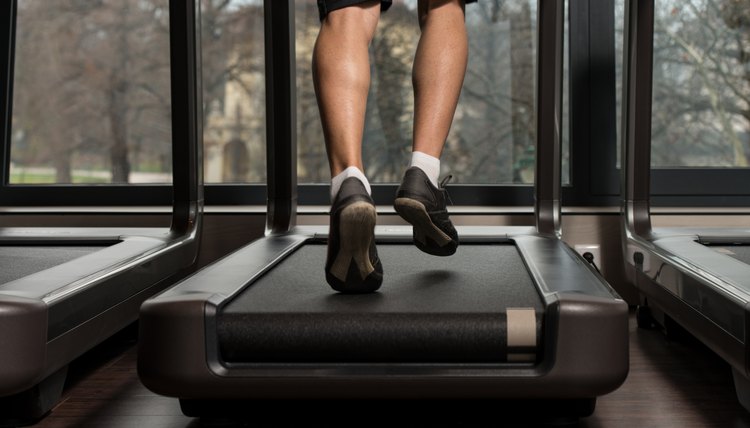What Muscles Support the Ankle?

The ankle joint is a strong joint that can support up to 1.5 times your body weight when you walk, according to eOrthopod. For this reason, your ankle has several strong muscles that support it, providing stability. These muscles allow movement in the ankle, helping you to point, flex and circle the foot. Knowing about the muscles on the ankle help you to reduce injury risk.
Peroneals
The peroneal muscles feature two divisions: the peroneus longus and the peroneus brevis muscles. These muscles wrap around the arch of the foot and past the ankle. Combined with the tibialis muscles, the peroneal muscles work to support and stabilize the ankle. When you walk on an uneven surface, your peroneal muscles are the ones that support you. If the muscles becomes injured, your body can work out of balance, causing the foot to frequently invert, or turn inwards. Patients who experience this type of injury may be prone to ankle sprains, according to Podiatry Today. You also may observe a drop in the arch of the foot.
Calf Muscles
Two muscles comprise the calf muscle on the back of the lower leg: the soleus and gastrocnemius muscles. These muscles lie on top of each other. The soleus is underneath the gastrocnemius. Both connect to the back of the ankle up to the back of the knee. These muscles support the back of the ankle and help to bend the ankle as you point the foot. Damage to either muscle affects your ability to point the toes. This also can cause pain and muscle tightness. Tightness in the calf muscles is common in athletes, as frequent running places strain on the calf muscles.
Posterior Tibialis
The posterior tibialis muscle works with your peroneal muscles to stabilize the ankle. This muscle starts behind your shin and connects to the inside part of your ankle -- known as the medial malleolus. This muscle helps to point the foot and turn it inward. If your posterior tibialis becomes injured, you may experience a drop in your arch or pain in the back of the leg. Rehabilitation and custom-made insoles can be used to treat posterior tibialis injuries. Unlike injury to the peroneal muscles, injury to the posterior tibialis results in difficulty moving the outside of the foot.
Explore In Depth
References
- eOrthopod: Ankle Anatomy
- SportsInjuryClinic.net: Peroneus Brevis
- Podiatry Today: Understanding the Impact of Muscle Weakness
- American Academy of Orthopaedic Surgeons: Sprained Ankle
- American Academy of Orthopaedic Surgeons. OrthoInfo. Achilles Tendinitis. Reviewed June 2010.
- American Academy of Orthopaedic Surgeons. OrthoInfo. Arthritis of the Foot and Ankle. Reviewed March 2015.
- American Academy of Orthopaedic Surgeons. OrthoInfo. Ankle Fractures (Broken Ankle). Reviewed March 2013.
- Arthritis Foundation. Arthritis and Diseases that Affect the Ankle.
- Robati S, Porter K, Shahid M, Crompton T, Sandiford N. Ankle osteomyelitis: an unusual presentation. JRSM Short Rep. 2013;4(6):35. doi:10.1177/2042533313476682.
- Merck Manual Consumer Version. Tarsal Tunnel Syndrome. Revised March 2018.
- U.S. National Library of Medicine. MedlinePlus. Common peroneal nerve dysfunction. Reviewed August 7, 2017.
- Mascard E, Gaspar N, Brugières L, Glorion C, Pannier S, Gomez-brouchet A. Malignant tumours of the foot and ankle. EFORT Open Rev. 2017;2(5):261-271. doi:10.1302/2058-5241.2.160078
- Tiemstra JD. Update on acute ankle sprains. Am Fam Physician. 2012;85(12):1170-6.
- American Academy of Orthopaedic Surgeons. OrthoInfo. Sprained Ankle. Reviewed February 2016.
- Arthritis Foundation. Lab Tests for Diagnosing Ankle Problems.
- Merck Manual. Professional Version. Cellulitis. Reviewed September 2019.
- American Academy of Orthopaedic Surgeons. OrthoInfo. Compartment Syndrome. Reviewed October 2009.
- American Academy of Orthopedic Surgeons. (n.d.). Arthritis of the Foot and Ankle.
- American Academy of Orthopedic Surgeons. (n.d.). Sprained Ankle.
- Koehler SM, Eiff P. (2018). Overview of Ankle Fractures in Adults. Asplund CA, ed. UpToDate. Waltham, MA: UpToDate Inc.
- Mascard E, Gaspar N, Brugieres L, Glorion C, Pannier S, Gomez-Brouchet A. Malignant tumours of the foot and ankle. EFORT Open Rev. 2017 May;2(5):261-71.
- Robati S, Porter K, Shabid M, Crompton T, Sandiford N. Ankle osteomyelitis: An unusual presentation. JRSM Short Rep. 2013 Jun;4(6):35.
Writer Bio
Rachel Nall began writing in 2003. She is a former managing editor for custom health publications, including physician journals. She has written for The Associated Press and "Jezebel," "Charleston," "Chatter" and "Reach" magazines. Nall is currently pursuing her Bachelor of Science in Nursing at the University of Tennessee.
